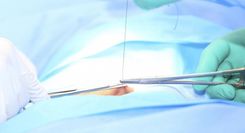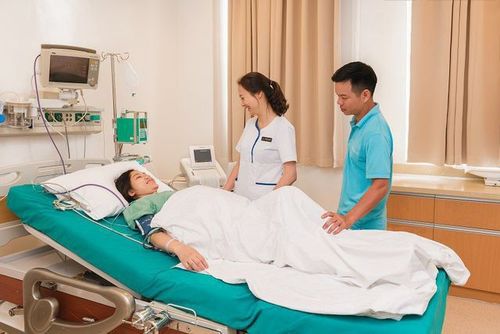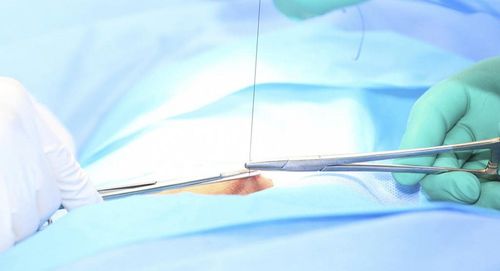1. The Appropriate Time for a Second C-Section
The timing of a second C-section depends significantly on the mother’s health condition and the maturity of the fetus.
In general, for a healthy mother, with a healthy fetus, the most appropriate time to perform a C-section is at 39 weeks of gestation. At this stage, the fetus has reached full maturity in respiratory, digestive, and cardiovascular functions, ensuring the baby can survive independently after birth. The second C-section is performed before the onset of labor pains, as contractions can affect the previous surgical scar, increasing the risk of uterine rupture due to scar dehiscence.
From 37 weeks, the baby can breathe independently and survive in the external environment, however, it is recommended for pregnant women to give birth at 39 weeks since, at this time, the baby’s organs have achieved full and comprehensive development. Babies born at 39 weeks are less likely to experience postnatal complications such as respiratory distress, hypothermia, or hypoglycemia than those born earlier.
In cases where the mother’s health is not optimal, or there is a history of stillbirth, ectopic pregnancy, or preterm delivery, the safest time for delivery is at 38 weeks. Additionally, in situations involving fetal abnormalities such as macrosomia, polyhydramnios, or oligohydramnios, an earlier second C-section may be necessary to ensure the safety of both the mother and the baby.
During prenatal check-ups, especially in the later months of pregnancy, doctors will thoroughly assess the mother’s health status, including abdominal pain, the integrity of the previous surgical scar, and the dilation and effacement of the cervix, as well as evaluate the baby’s maturity. The results, including fetal heart rate, weight, and the condition of the placenta and amniotic fluid, are crucial factors in determining the timing of the second C-section. If any abnormalities in the health of the fetus or the mother are detected, the doctor will immediately recommend a second C-section to minimize risks for both the mother and the baby.
2. Abnormalities Mothers Should Be Aware of During a Second C-Section.
Pregnant women undergoing a second cesarean delivery need to pay special attention to changes in their own bodies and their baby, immediate hospitalization is required in the following cases of abnormalities:
Intermittent and continuous abdominal pain
For women delivering vaginally, abdominal pains signals the onset of labor. However, for those undergoing a second cesarean delivery, intermittent and continuous pain, especially at the site of the previous incision, may signal a potential rupture of the old scar. This is a dangerous sign of uterine rupture, which can lead to maternal shock and fetal death.
Abnormal vaginal bleeding
Vaginal bleeding at any stage of pregnancy requires timely medical intervention. Pregnant mothers may experience bleeding during the early stages of the first trimester, which could be a sign of a threatened miscarriage or an ectopic pregnancy.. Vaginal bleeding in the later months of pregnancy could indicate placental abnormalities, such as placenta previa, placental abruption, or preterm labor.
Abnormal vaginal discharge
If vaginal discharge increases significantly, is persistent or sudden, and appears sticky with a strong fishy odor, the pregnant woman should go to the hospital immediately, as this could be a sign of amniotic fluid-related abnormalities, such as leaking amniotic fluid, premature rupture of membranes, or preterm premature rupture of membranes.
These conditions may increase the risk of umbilical cord prolapse, preterm labor, or amniotic infection.
Decreased fetal movements or unusual movements
Normally, fetal movements can be felt as early as the 16th week of pregnancy, becoming more pronounced in the later weeks. Fetal movements are considered a signal indicating that the baby is developing normally in the womb.
Mothers should monitor their baby’s movements daily, such as kicks, punches, rolls, or turns within one hour, and note the time it takes for the fetus to perform 10 movements. If fetal movements decrease, or the total number of movements is fewer than 10 within a 2-hour period, this is a dangerous sign requiring immediate medical attention.
Besides, any unusual health symptoms in the mother, such as a high fever above 38°C, headaches, dizziness, blurred vision, or fainting, require immediate evaluation at the nearest medical facility.
3. The Safe Timing for Pregnancy and a Second C-Section
According to experts, the uterine incision from the first C-section needs sufficient time to heal completely, with a recommended interval of at least 2 years after the initial surgery. This duration allows the mother to fully recover and ensures comprehensive development for the fetus.
If the interval between two pregnancies is less than 6 months, the risk of rupturing the previous incision increases, as the scar has not fully healed, and the mother’s body is not yet adequately prepared for another pregnancy, negatively affecting fetal development.
The decision to conceive and undergo a second C-section depends on various factors, as it carries significant risks for both the mother and the baby. Therefore, the mother and her family should consult with a doctor to choose the appropriate timing and make thorough preparations in all aspects to ensure a safe pregnancy and the birth of healthy babies.
To arrange an appointment, please call HOTLINE or make your reservation directly HERE. You may also download the MyVinmec app to schedule appointments faster and manage your reservations more conveniently.













